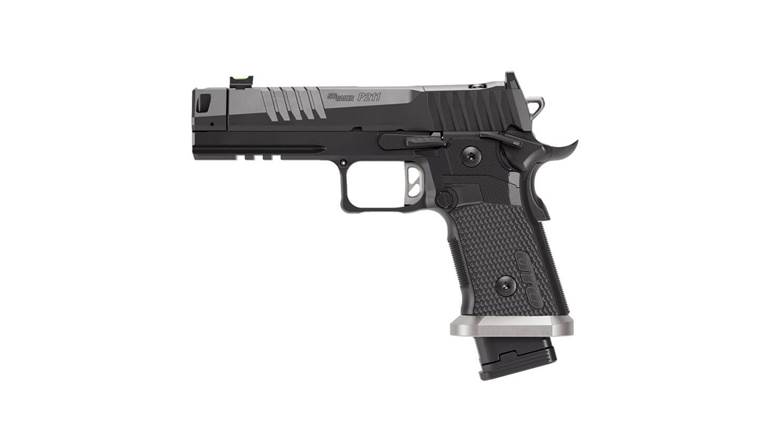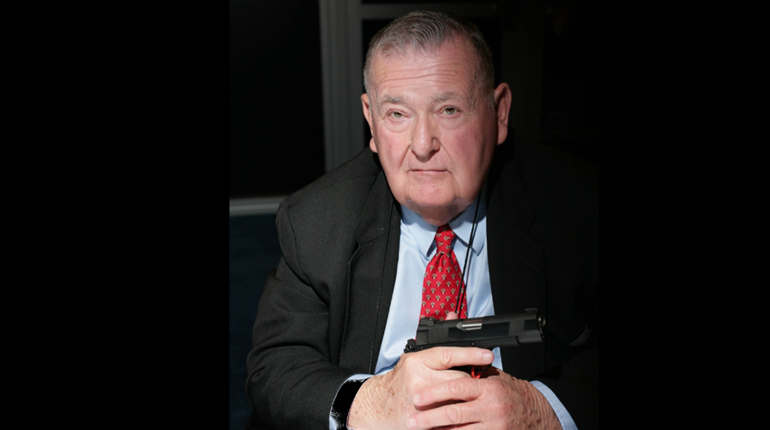
4/25/2013
Two years ago, 2011, was a time of considerable celebration as the much beloved Colt M1911 pistol completed a century of service to Americans. In 2012, we were pleased to see the M1911 return to official status with the adoption of a Colt-made M1911 Rail Gun for Marine Corps use. Undeniably, most American shooters are at least interested in U.S. service pistol development and use, if not in personal ownership of the guns in question. Civilian sales of the Beretta 92F pistols spiked after U.S. forces adopted the same gun as the M9. Another handgun that is currently in active service with the U.S. military, yet goes relatively unmentioned and unappreciated, is the SIG SAUER M11 in 9 mm Luger, once known as the P228.
I recently evaluated a new version of the gun designed for the civilian market. It is called the M11-A1, and what follows is my take on the pistol, the reasons for the difference in nomenclature and how the M11 relates to the M11-A1. First, we need to look at a little history to establish a sound basis for the comparison.
SIG SAUER’s P-series pistols date back to the 1970s. The SIG SAUER name represents a combination of two highly regarded makers—J.P. Sauer & Sohn of Germany and Schweizerische Industrie-Gesellschaft (SIG) of Switzerland. In the early days, the guns were imported into the U.S. by several firms—Hawes, Interarms, Browning—before the company started an importation branch of its own in the United States. At present, the firm continues to import some of the P-series pistols, but also manufactures the vast majority at its Exeter, N.H., facility. One such gun is the P220, which was the first import, and a gun that established the worth of several innovative features. In brief, the P220 was a full-size, recoil-operated, service semi-automatic in a number of popular chamberings—.45 ACP, .38 Super, 9 mm Luger and .30 Luger. Since the gun was available as a .45 and had a double-action/single-action trigger system, it was instantly popular in an America starved for such things. The P225 and P226 followed closely after the P220. Both were 9 mm Luger guns, developed for police service pistol trials in Germany and military service pistol trials in the United States. Eventually, of course, the 15-round-capacity P226 lost out to another make and model—the Beretta Model 92FS—but went on to great success in American law enforcement.
It was innovative in a number of features, but two of them stand out. One is tactical, the other mechanical. First, the lockwork of all the P-series guns to this point was different among a host of other double-action designs. Here, the decocker on the upper front corner of the left grip performed a single function—it decocked the hammer. Other pistols worked a manual safety into the design, but the SIG SAUER designers correctly perceived that the long-arc double-action pull for the first shot was safe in its similarity to trigger pulls on double-action/single-action revolvers. After the first shot, the recoiling slide cocked the hammer for single-action trigger pull for subsequent shots. Tactically, that made great sense—a flick of the thumb and a cocked pistol returned to hammer-down, double-action ready status.
The second major innovation was the use of a pistol slide made of several parts. The slide’s main portion was formed from a single piece of heavy gauge sheet steel in a pressing operation. Other parts were welded in place and the slide required less machining to become the upper half of a functioning pistol. That construction technique has proved completely serviceable for 40 years. When first used on early P220s, it scared the devil out of critics, but most of those guns are still working perfectly.
While the early P-series pistols covered a lot of bases, there was room in the line for some other models. In the mid-1980s, SIG SAUER offered a new 9 mm Luger model for concealed carry. Essentially an abbreviated P226, the P228 was shorter in length and height and had a 13-round capacity. Compared to the 15-round-capacity P226, the gun was significantly smaller even though it gave up only two rounds. By today’s standards, it was a medium-size pistol, but in the ’80s, it was the smallest full-capacity 9 mm available. An instant hit with police and civilian shooters, the concealable P228 began to attract attention in other quarters. I have been privileged to speak at length with a former SIG employee who was deeply involved in the process, but the military began a series of evaluations (sometimes downright bizarre) that led to the adoption of the P228 as an official U.S. sidearm. In the vast U.S. military establishment, there is a considerable need for handguns for people working in civilian clothes. Therefore, in 1988, military-marked and -finished SIG SAUER P228s went into U.S. service officially designated as the M11 pistol. Military investigators in Army, Navy and Air Force units, as well as Department of Defense personnel, use this excellent handgun. Once a pistol has achieved such status, it may be ordered, with proper justification, by any element of the Department of Defense. Use of the M11 (P228) is growing to include Naval aviators and others, who have an obvious need for compact survival equipment.
Although that was the beginning of the P228-as-M11 story, there are some other interesting twists and turns along the way. When a new mid-bore pistol cartridge came along in 1990, it took both civilian and law enforcement markets by storm. The robust little .40 S&W was an overnight sensation and is now the most popular law enforcement cartridge. Naturally, SIG SAUER wanted a piece of that market, but moved cautiously forward on designing a gun to handle the more powerful cartridge. In time, the solidly established firm introduced a new model known as the P229. It was a dead ringer for the P228, with one major exception. Instead of a multi-piece slide, the P229 used a conventional milled steel unit. The first makers of .40 S&W pistols quickly determined that the new wonder cartridge was something of a troublemaker. It was indeed a compact powerhouse in the terminal ballistics sense, but at the cost of high slide velocity and accelerated wear in general. It could be made to work, but engineers at SIG SAUER decided to use a solid slide and strong springs. The P229 has earned a good reputation in some 20 years of hard service. Eventually, the solid slide was used for P229s in the company’s proprietary cartridge, the .357 SIG. And not surprisingly, the concept spread to other SIG pistols in other chamberings—9 mm, .45 ACP, etc. As of 2012, all pistols in the P-series are manufactured with the one-piece slide.
The reader should not infer that there is something weaker, less satisfactory or outmoded about the SIG SAUER pistols with sheet steel slides. There is no particular reason for a company to build slides in two different ways, so when cartridges came along that required it, the company simply changed to the same method for all pistols in the P-series. With one exception, that is. When the government adopted the P228 in 9 mm as the M11, the gun was made with the multi-piece slide. It cannot be changed unless the military agrees to a modification. Chambered for the 9 mm Luger service cartridge and no other, the M11 (P228) is just fine the way it is. The P228 pistol is no longer in the commercial line; it has been replaced by the P229 in 9 mm. Even the terminology of P228 is no longer used.
The newest pistol in the catalog, however, is the M11-A1, a redesignated version of the P229 in 9 mm. It has most of the features of the M11, but is different enough to warrant a military-style nomenclature change. Obviously, SIG SAUER wanted to offer the discriminating civilian shooter a pistol that is as close to the military gun as possible. In appearance, the M11-A1 is almost exactly the same gun as the G.I. M11. The markings are different, but the finish, sights, controls and handling of the pistol are the same. A sample gun loaned to me by the New Hampshire maker proved to be an accurate and reliable service handgun.
The M11-A1 is a solid, rather chunky handful of gun that is a bit smaller than the typical military duty pistol. Recall that compactness was a design criterion for service use. Measuring 7.1x 5.4 x 1.5 inches and weighing 32 ounces, it would hide away in a pilot’s flight suit or investigator’s civilian clothes with ease. Finish is a dull nitride on the steel slide and black anodize on the aluminum-alloy receiver. Two-piece plastic stocks have a stippled surface that adheres well to the hand. As a bonus, the dovetailed three-dot sights feature SigLite tritium inserts. Controls are the familiar SIG SAUER type. At the top edge of the left side of the receiver and running forward, you’ll find the slide lock, decocker and takedown latch. The decocker serves no function other than to decock the hammer. This is a pure double-action/single-action trigger system, where the first shot requires a long arc, double-action trigger pull, after which the recoiling slide cocks the hammer for subsequent ones in single-action. The trigger system is the “SRT” style, which means short reset trigger. After firing the first shot, the shooter holds the trigger to the rear as the slide cycles. A very slight release of pressure allows the trigger to move a short distance forward to a point where it resets. As much as DA/SA trigger systems were once roundly cursed on training ranges, this is a superb system that requires training, but makes the gun both accurate and fast to use. It is a very nice gun to shoot.
Before I describe our range session, I need to mention the magazine situation. For one thing, the M11-A1 comes with three magazines. If you look closely at the magazine well, you will see that it is slightly wider than the P228’s. The designers adjusted the geometry of the 13-shot magazine that works well in the P228 and ended up with a 15-shot unit. As far as I have been able to determine, the military-issue M11s still use the 13-round magazines. In this particular feature, the M11-A1 is (two rounds) better than the M11.
At the range, the gun exhibited no malfunctions throughout several hundred rounds of informal plinking and accuracy testing. The trigger is better than any other SIG SAUER pistol I have ever fired, and I find that I could recover quickly for second shots. To evaluate accuracy, I fired the M11-A1 from a Ransom Rest with three kinds of commercial ammunition. I have been testing SIG SAUER pistols that way for 28 years and have come to expect tight groups. No disappointments here—the M11-A1 exhibits fine accuracy. It performed best with Federal’s 147-grain Hydra-Shok, producing five-shot groups at 25 yards averaging 2 inches, which included one that measured 1.19 inches.
It would seem that SIG SAUER has produced another fine pistol. This one is a great example of military-grade thinking and equipment trickling down to the civilian market. The result is one of the best possible choices for a mid-sized service pistol.
Manufacturer: SIG SAUER, Inc.; (603) 772-2302; www.sigsauer.com
Caliber: 9 mm Luger
Action Type: recoil-operated, double-action/single-action, center-fire, semi-automatic pistol
Frame: anodized aluminum alloy
Barrel: 3.9"
Rifling: 1:16" RH twist
Magazines: detachable box; 15-round capacity
Sights: SigLite with tritium inserts
Trigger Pull: double-action, 10 lbs.; single-action 4 lbs., 6 ozs.
Overall Length: 7.1"
Width: 1.5"
Height: 5.4"
Weight: 32 ozs.
Accessories: lockable hard case, cable lock, manual, two spare magazines
Suggested Retail Price: $1,125





































